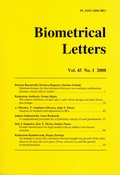

|
ANALYSIS OF RESIDUALS AND ADJUSTMENT IN JRA
A. Oliveira1, T. Azinheira Oliveira1,2, Joao T. Mexia3 1UAb, Department of Exact and Technologic Sciences, R. Fernao Lopes, 9, 2o D, 1000 132 Lisbon, Portugal, e-mail: aoliveira@univ-ab.pt, toliveir@univ-ab.pt 2CEAUL, Center of Statistics and Applications, University of Lisbon 3Department of Mathematics, FCT- New University of Lisbon, Quinta da Torre, 2825 Monte da Caparica, Portugal, e-mail: jtm@fct.unl.pt |

Joint Regression Analysis (JRA) is based in linear regression applied to yields, adjusting one linear regression per cultivar. The environmental indexes in JRA correspond to a non observable regressor which measures the productivity of the blocks in the field trials. Usually zig-zag algorithm is used in the adjustment. In this algorithm, minimizations for the regression coefficients alternate with those for the environmental indexes. The algorithm has performed very nicely but a general proof of convergence to the absolute minimum of the sum of squares of residues is still lucking. We now present a model for the residues that may be used to validate the adjustments carried out by the zig-zag algorithm.

Joint Regression Analysis, ziz-zag algorithm, residuals.
